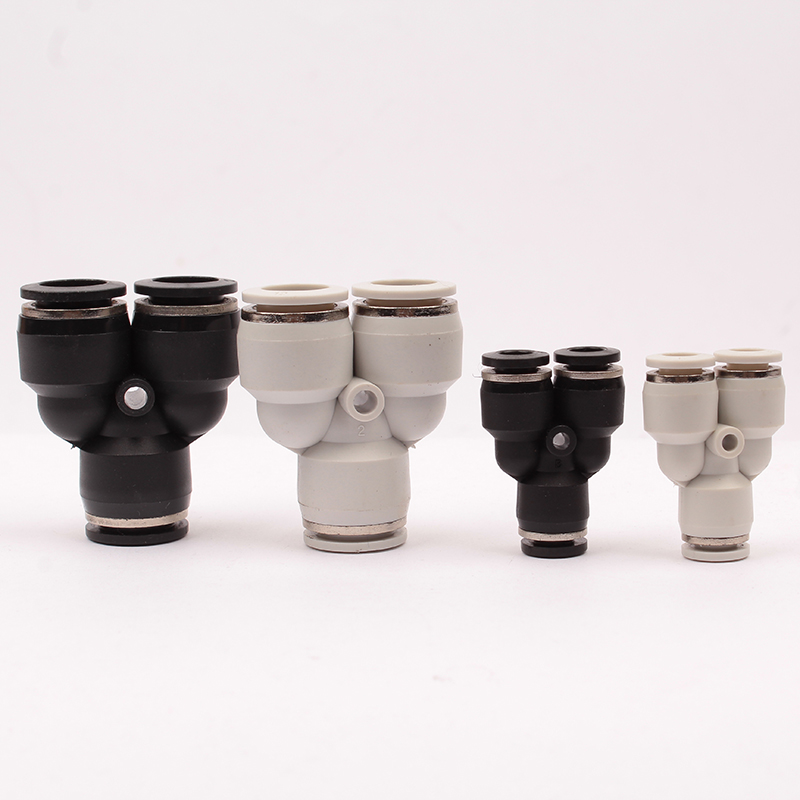Throttle speed regulating valve SL
- Model:
- SL-A/SL-B
- MOQ:
- 10
- Place of Origin:
- China
- Usage:
- pneumatic quick connector
- Application:
- Pneumatic Fittings Air Tools Quick Coupling Hose Connector
Description
Pneumatic joints are generally produced using PU raw materials, with stable quality, high pressure resistance, weather resistance, wear resistance, bending resistance, smooth and flexible pipe body, bright color, high elasticity, resistance to bending, and small bending radius
Key Features
There are three types of pneumatic connectors:
1. Two end open close type:
When linking - When the descendant is inserted into the parent body, the collar returns to its original position under the action of the spring, the steel ball rolls and locks the descendant body tightly, and the valve between the parent body and the font pushes each other to open, allowing fluid to flow. The O-ring can completely block fluid leakage.
2. Open end
When not linked: When the ferrule of the parent body is pushed to the other end, the steel ball automatically rolls outward, thus the child body is removed; Due to the lack of valves in both the font and matrix, fluid flows outward.
Link: When the descendant is inserted into the mother body, the ferrule is pushed to the previous position by the force of its spring, causing the steel ball to lock and the fluid to flow. The O-ring inside prevents liquid leakage
3. Single circuit open close type
When not connected: When the ferrule of the parent body is moved to the other end, the stainless steel ball automatically rolls outward, and the child body is opened by the reaction force of the valve spring. The valve can automatically close to block fluid flow.
When connecting: When the descendant is inserted into one side of the mother body with a collar, the valve is opened, causing fluid to flow. The washer is pushed back to its original position by the force of the spring, and the stainless steel ball is locked to ensure the connection between the descendant and mother body. The washer inside can completely block fluid leakage
Applications
Pneumatic Systems: The Solenoid Valve is extensively used in pneumatic control systems to regulate air flow for equipment operation and automation.
Hydraulic Systems: It plays a crucial role in hydraulic circuits, controlling the flow of hydraulic fluid for precision movement and system safety.
Process Control: In industries such as chemical processing, Solenoid Valves are employed to monitor and regulate the flow of liquid and gas in various production processes.
HVAC Systems: Solenoid Valves are often utilized in heating, ventilation, and air conditioning systems to control the flow of refrigerant gases and ensure efficient cooling or heating.
Water Treatment: They are widely used in water treatment plants for automatic control of water flow, preventing overflow, and maintaining optimal water levels.
In conclusion, the Solenoid Valve proves to be an essential component in various industrial applications. Its reliable performance, fast response time, and versatility make it an ideal choice for controlling fluid and gas flow. With its wide range of applications and ease of installation, the Solenoid Valve is a reliable and efficient solution for numerous industries.
Specifications
The difference between throttle valve and speed regulating valve
1 Throttle valve is to adjust and control the size of the opening in the valve directly limit the flow through the fluid to achieve the purpose of throttling. Because it is forced to block throttling, a large pressure difference will be generated before and after throttling, and the pressure loss of the controlled fluid is relatively large, which means that the pressure after throttling will be reduced. 2. The speed regulating valve is based on the throttle throttle principle, and a set of pressure compensation device is added to the internal structure of the valve, which improves the phenomenon of large pressure loss after throttling, so that the pressure of the fluid after throttling is basically equal to the pressure before throttling, and reduces the heat of the fluid. Speed control valve is generally divided into two-way speed control valve and three-way speed control valve, two-way speed control valve is composed of a fixed difference pressure reducing valve and a throttle valve in series, three-way speed control valve is composed of a fixed difference relief valve and a throttle valve in parallel, but they all have a common characteristic: That is, keep the pressure difference of the throttle valve into and out of the oil port basically constant, so that the flow through the throttle valve is only related to the opening of the valve port A, which is unrelated to the load pressure fluctuation. The speed regulating valve also seems to be called the compensation valve. The throttle valve is like a faucet, you twist the big water will flow more, but in the case of the same number of turns of the faucet, the pressure in the pipeline is high, the water will flow more, and the pressure is small. But the speed control valve is not the same amount of water flow no matter how high the pressure in the pipe is (relative) when the faucet is turned the same number of turns.
2, the speed control valve is a pressure compensation throttle valve. It has a constant difference pressure reducing valve and a throttle valve in series. The front and rear pressure p2 and p3 of the throttle valve are led to the right and left ends of the pressure reducing valve spool respectively. When the load pressure p3 increases, the liquid pressure at the left end of the pressure reducing valve spool increases, the spool moves to the right, the pressure relief port increases, and the pressure drop decreases, so that p2 also increases and the pressure difference of the throttle valve (P2-P3) remains unchanged. And vice versa. This is the speed control valve flow constant (not affected by the load)














